Desert
- A desert is a barren area of landscape where little precipitation occurs and, consequently, living conditions are hostile for plant and animal life. The lack of vegetation exposes the unprotected surface of the ground to the processes of denudation. About one-third of the land surface of the world is arid or semi-arid.
- This includes much of the Polar Regions, where little precipitation occurs, and which are sometimes called polar deserts or “cold deserts“. Deserts can be classified by the amount of precipitation that falls, by the temperature that prevails, by the causes of desertification, or by their geographical location.
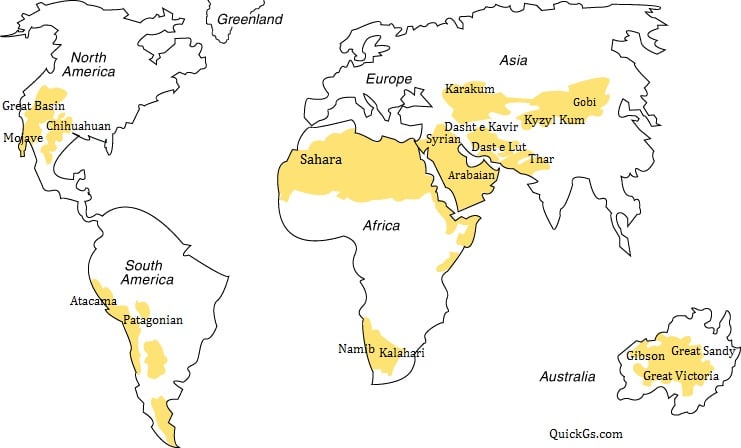
- About 1/5 of the world’s land is made up of deserts.
- Deserts that are absolutely barren, where nothing grows are known as true deserts.
- Insufficient & irregular rainfall, high temperature & rapid rate of evaporation are the main causes of the desert’s aridity.
- Almost all the deserts are confined within 15 degree – 30 degree parallels to N-S of the equator known as trade wind deserts or tropical deserts.
- They lie in the trade wind belt on the western parts of the continents.
- Offshore trade winds are often bathed in cold currents which produces a desiccating (dehydrating) effect, hence moisture is not easily condensed into precipitation.
Types of desert
- Hamada/Rocky Desert
- Consist of large stretches of bare rocks, swept clear of sand & dust by wind.
- Exposed rocks are thoroughly smoothened, polished & highly sterile
- Reg/Stony Desert
- Composed of extensive sheets of angular pebbles & gravels which the wind is not able to blow off.
- Stony deserts are more accessible than sandy deserts & large herds of camels kept there.
- Erg/Sandy Desert
- Also known as the sea of sand
- Winds deposit vast stretches of undulating sand dunes in the direction of winds
- Badlands
- Consists of gully & ravines formed on hill slopes & rock surfaces by the extent of water action
- Not fit for agriculture & survival
- Finally leads to the abandonment of the entire region by its inhabitant
- Mountain Deserts
- Deserts which are found on the highlands such as on plateaus & mountain ranges, where erosion has dissected the desert highland into rough chaotic peaks & uneven ranges.
- Their steep slopes consist of Wadis (dry valleys) with sharp & irregular edges carved due to the action of frost.
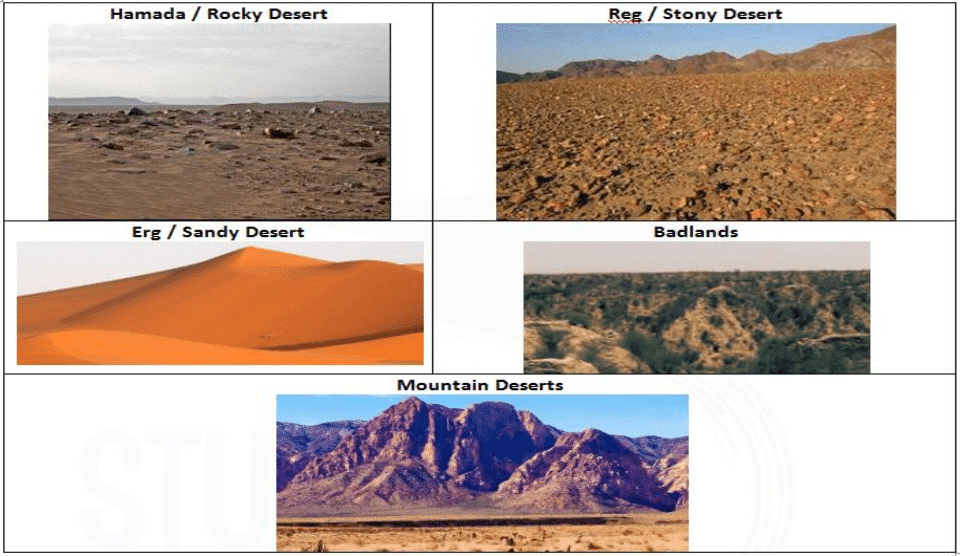
Mechanism of Desert/Arid Erosion
- Weathering
- Most potent factor in reducing rocks to sand in arid regions.
- Even though the amount of rain that falls in a desert is small, but manages to penetrate into rocks & sets up chemical reactions in various minerals it contains.
- Intense heating during the day & rapid cooling during the night by radiations, set up stresses in already weakened rocks, hence they eventually crack.
- When water gets into cracks of a rock, it freezes at night as the temperature drops below the freezing point & expands by 10 % of its volume.
- Successive freezing will prise of fragments of rocks which get accumulated as screes.
- As heat penetrates rock, its outer surface gets heated & expands, leaving its inner surface comparatively cool.
- Hence, outer surface prise itself from the inner surface & peels o
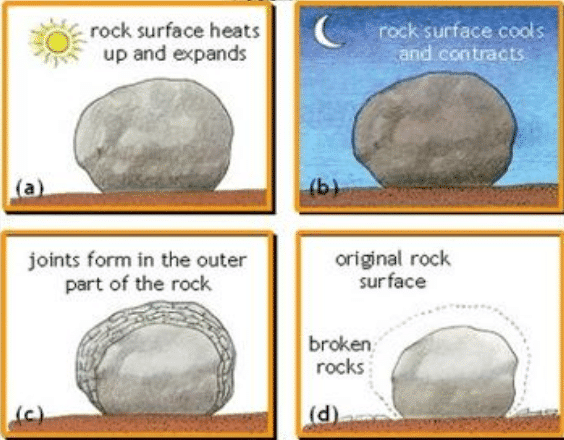
- Action of Wind
- Efficient in arid regions as little vegetation or moisture to bind the loose surface materials.
- It is carried out in the following ways:
- Deflation
- Involves lifting & blowing away of loose materials from the ground
- Blowing capacity depending largely on the size of the material lifted from the surface
- Finer dust & sands may be removed miles away from their place of origin & may get deposited even outside the desert margins.
- Deflation results in the lowering of the land surface to form large depressions called Deflation hollows.
- Abrasion
- Sandblasting of rock surfaces by the wind when they hurl sand particles against them
- This results in rock surfaces being scratched, polished & worn away
- Abrasion is most effective near the base of the rocks, where the amount of material the wind is able to carry is greatest.
- This explains why telegraphic poles in the deserts are protected by covering of metal for a foot or two above the ground.
- Attrition
- When wind-borne particles roll against one another in the collision, they wear each other away
- Hence their sizes are greatly reduced & grains are rounded into millet seed sand.
- Deflation
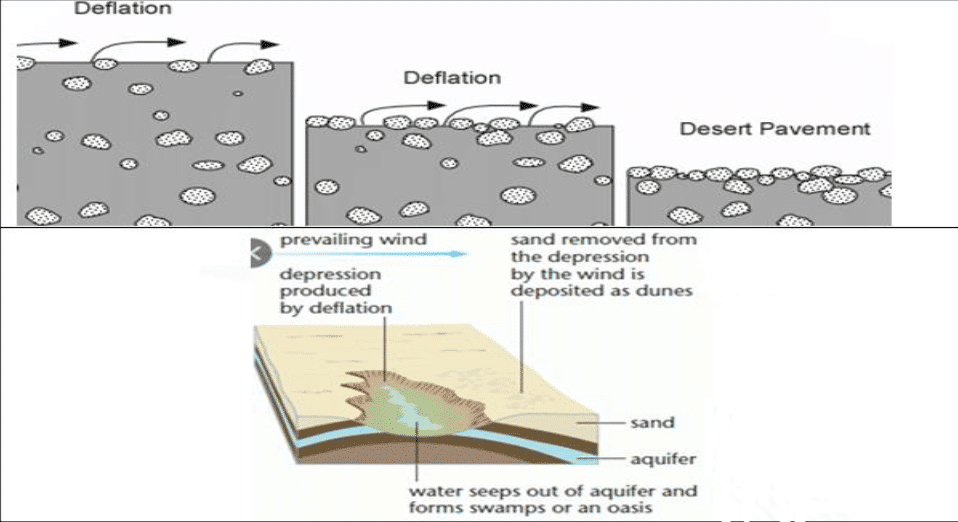
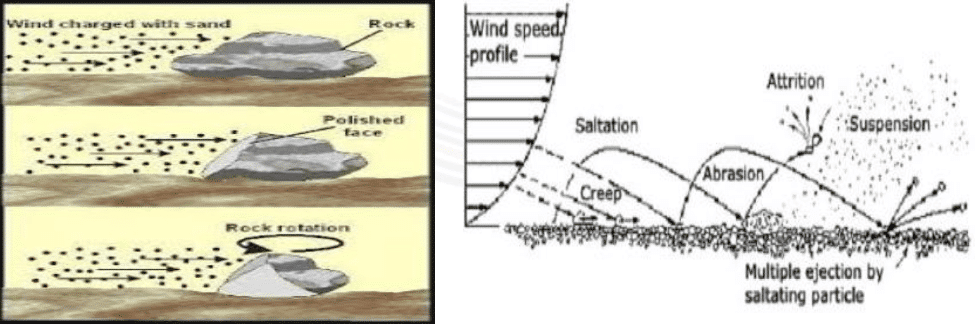
Desert Landforms by Wind Erosion
- Rock pedestals/Mushroom rocks
- Formed by the sandblasting effect of winds against any projecting rock masses
- It wears down the softer layer leading to the formation of irregular edges on alternate bands of softer & harder rocks.
- Grooves & hollows cut in the rock surfaces, carve them into grotesque-looking pillars known as rock pedestals.
- Such rock pillars will be further eroded near their bases where friction is greatest.
- This process of undercutting produces rocks of mushroom shape called mushroom rocks.
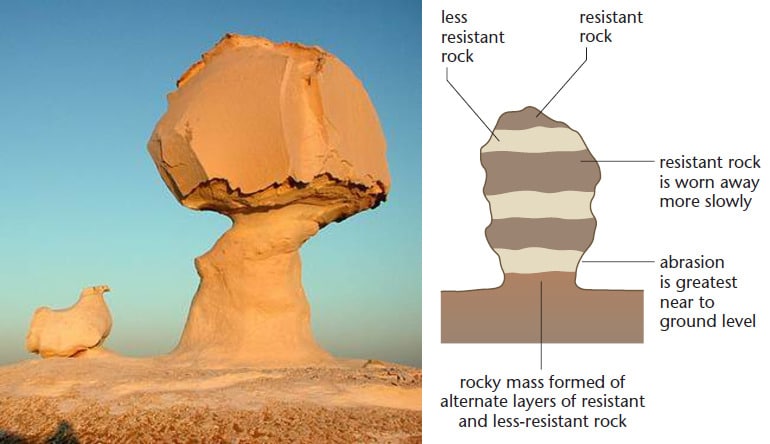
- Messa and Butte
- Mesa is a Spanish word meaning ‘table’. It is a flat, table-like landmass with a very resistant horizontal top layer and very steep sides. The hard stratum on the surface resists denudation by both wind and water, and thus protects the underlying layers of rocks from being eroded away.
- Mesas may be formed in canyon regions e.g. Arizona, or on fault blocks e.g. the Table Mountain of Cape Town, South Africa. Continued denudation through the ages may reduce mesas in the area so that they become isolated flat-topped hills called buttes.
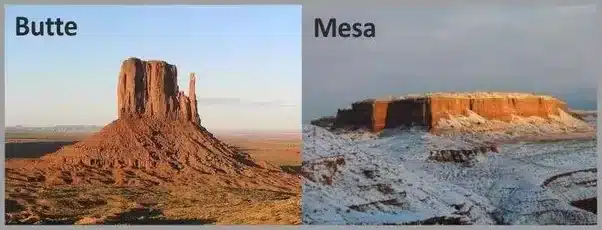
- Zeugen
- Tabular masses which have a layer of soft rocks lying beneath a surface layer of more resistant rocks
- Difference in the erosional effect of the wind on soft & resistant rock surfaces, carve them into weird looking ridge & furrow landscape
- Mechanical weathering initiates their formation by opening up joints of the surface rocks
- Wind abrasion further eats into the underlying softer layer so that deep furrows are developed
- The hard rock then stand above the furrows as ridges or Zeugen
- Zeugen may stand 10 to 100 feet above the sunken furrows
- Continuous abrasion by winds gradually lowers the Zeugen & widens the furrow.
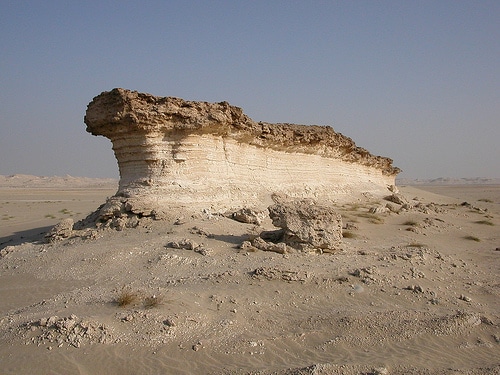
- Yardangs
- Yardangs looks quite similar to Zeugen but instead of lying in horizontal strata upon one another, the hard & soft rocks of Yardangs are vertical bands
- Rocks are aligned in the direction of prevailing winds.
- Winds abrasion excavates the bands of softer rocks into long, narrow corridors, separating the steep-sided over handing ridges of hard rock called Yardangs.
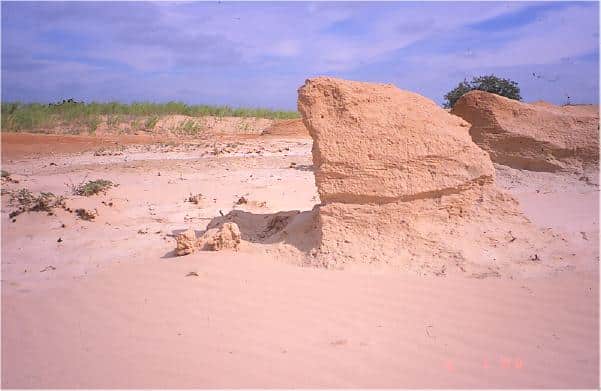
- Isenberg (Island Mountain)
- They are basically isolated residual hills rising abruptly from the ground level
- Characterized by very steep slopes & rather rounded tops
- They are often composed of granite or gneiss
- Are probably relics of an original plateau, which has been almost entirely eroded away.
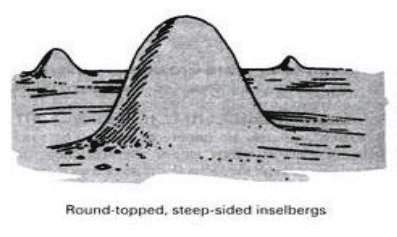
- Ventifacts & Dreikanter
- These are pebbles faceted by sand-blasting. They are shaped and thoroughly polished by wind abrasion to shapes resembling Brazil nuts. Rock fragments, mechanically weathered from mountains and upstanding rocks, are moved by wind and smoothed on the windward side.
- If the wind direction changes another facet is developed. Such rocks have characteristic flat facets with sharp edges.
- Amongst the ventifacts those with three wind-faceted surfaces are called dreikanter. These wind-faceted pebbles form the desert pavement a smooth, mosaic-like region, closely covered by the numerous rock fragments and pebbles.
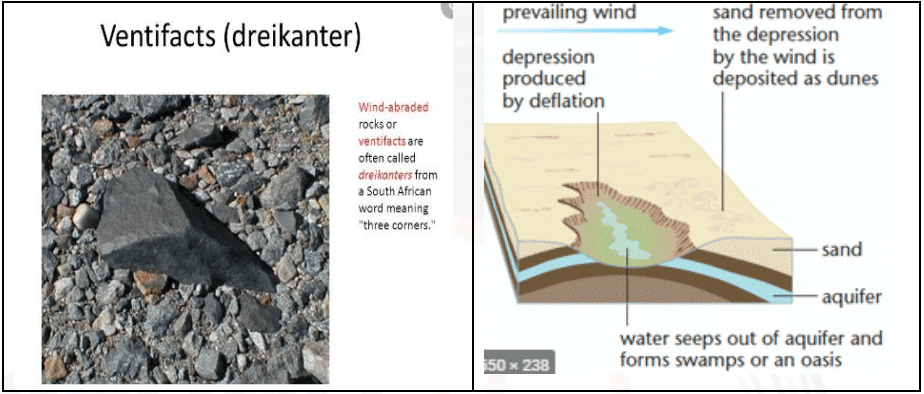
- Deflation Hollows
- Winds lower the ground by blowing away the unconsolidated materials, and small depressions may form. Similarly, minor faulting can also initiate depressions and the eddying action of on-coming winds will wear off the weaker rocks until the water table is reached.
- Water then seeps out forming oasis or swamps, in the deflation hollows or depressions.
- Large areas in the western U.S.A., stripped of their natural vegetation for farming, were completely deflated when strong winds, moved materials as dust storms, laying waste crops and creating what is now known as the Great Dust Bowl.
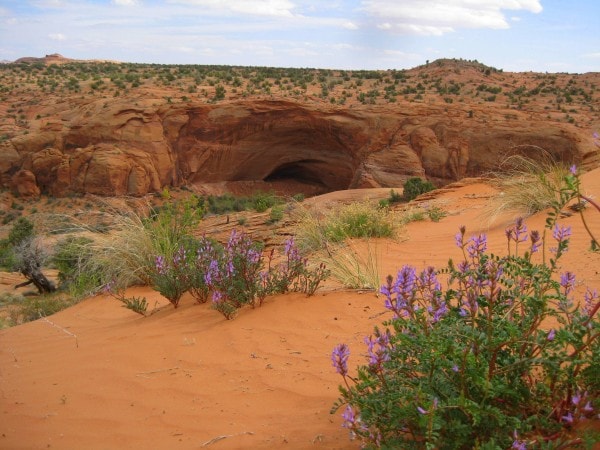
Deserts Landforms by wind deposition
- Materials eroded & transported by winds must come to rest somewhere.
- The finest dust travels enormous distances in the air sometimes as long as 2300 miles before they settle down.
- The dust from Sahara desert is sometimes blown across the Mediterranean to fall as blood rains in Italy or on the glaciers of Switzerland.
- Dust that settles in Hwang Ho basin (also known as Hwangtu – the yellow earth) from the Gobi desert has been accumulated over past centuries to a depth of several hundred feet
- As wind borne materials are shifted according to their coarseness, it can be expected that the coarser sands will be too heavy to be blown out of desert limits.
- They remain as dunes or other depositional landforms within desert themselves.
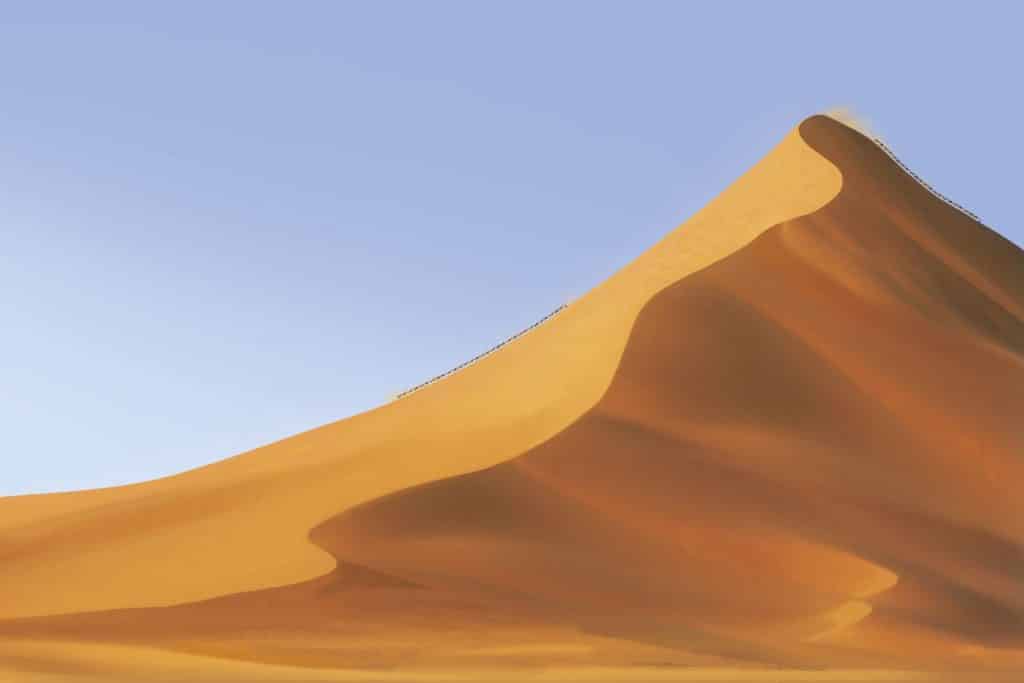
Dunes
- Dunes are, in fact, hills of sand formed by the accumulation of sand and shaped by the movement of winds.
- They may be active or live dunes, constantly on the move, or inactive fixed dunes, rooted with vegetation.
- Dunes are most well represented in the erg desert where a sea of sand is being continuously moved, reshaped, and re-deposited into a variety of features.
- Two most common types of dunes are Barchan & Seifs.
- Barchan:
- These are crescentic or moon-shaped dunes that occur individually or in groups. They are live dunes that advance steadily before winds that come from a particular prevailing direction. They are most prevalent in the deserts of Turkestan and in the Sahara.
- Barchans are initiated probably by a chance accumulation of sand at an obstacle, such as a patch of grass or a heap of rocks. They occur transversely to the wind, so that their horns thin out and become lower in the direction of the wind due to the reduced frictional retardation of the winds around the edges.
- The windward side is convex and gently sloping while the leeward side, being sheltered, is concave and steeps (the slip-face).
- The crest of the sand dune moves forward as more sand is accumulated by the prevailing wind.
- The sand is driven up the windward side and, on reaching the crest, slips down the leeward side so that the dune advances.
- The migration of the barchans may be a threat to desert life for they may encroach on an oasis burying palm trees or houses.
- Long-rooted sand-holding trees and grasses are therefore planted to halt the advance of the dunes thus preventing areas of fertile land from being devastated.
- Under the action of winds, barchans take a chaotic changing pattern. Several barchans may coalesce into a line of irregular ridges, ever-changing with the direction of the winds. Ergs or sandy deserts are thus most difficult to cross.

- Seifs or Longitudinal Dunes:
- They are long, narrow ridges of sand, often over a hundred miles long lying parallel to the direction of the prevailing winds. The Crestline of the seif rises and falls in alternate peaks and saddles in regular successions like the teeth of a monstrous saw.
- The dominant winds blow straight along the corridor between the lines of dunes so that they are swept clear of sand and remain smooth. The eddies that are set up blow towards the sides of the corridor, and, having less power, drop the sand to form the dunes.
- In this manner, the prevailing winds increase the length of the dunes into tapering linear ridges while the occasional crosswinds tend to increase their height and width. Extensive seif dunes are found in the Sahara Desert, south of the Qattara Depression; e.g. the Thar Desert and the West Australian Desert.
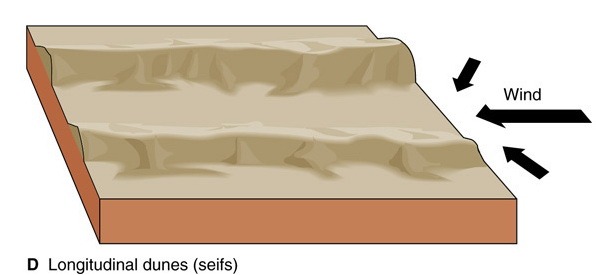
Loess
- The fine dust blown beyond the desert limits is deposited on neighboring lands as loess. It is a yellow, friable material and is usually very fertile. Loess is in fact, fine loam, rich in lime, very coherent, and extremely porous. Water sinks in readily so that the surface is always dry.
- Streams have cut deep valleys through the thick mantle of soft loess and badland topography may develop. It is so soft that roads constructed through a loess region soon sink and their walls rise steeply. The most extensive deposit of loess is found in northwest China in the loess plateau of the Hwang- Ho basin.
- It is estimated to cover an area of 250,000 square miles, and the deposits have accumulated to a depth of 200 to 500 feet! In China, such yellowish wind-borne dust from the Gobi Desert is called ‘Hwangtu’ — the yellow earth! But the original tern loess actually comes from a village in Alsace, France bearing that name, where such deposits occurred.
- Similar deposits also occur in some parts of Germany France and Belgium and are locally called Limon They are also wind-borne but were blown from material deposited at the edge of ice sheets during the Ice Ages. In parts of the Mid-West, U.S.A. loess was derived from the ice sheets which covered northern North America and is termed adobe.

Landform of water actions in desert
- Few deserts in the world are entire without rain or water. The annual precipitation may be small and comes in irregular showers. But thunderstorms do occur and the rain falls in torrential downpours, producing devastating effects.
- A single rainstorm may bring several inches of rain within a few hours, drowning people who camp in dry desert streams and flooding mud-baked houses in the oasis.
- As deserts have little vegetation to protect the surface soil, large quantities of rock wastes are transported in the sudden raging torrents or flash-floods. Loose gravels, sand, and fine dusts are swept down the hillsides.
- They cut deep gullies and ravines forming bad-land topography. Subsequent downpours widen and deepen the gullies when they wash down more soft rocks from the surface. There is so much material in the flash floods that the flow becomes liquid mud.
- When the masses of debris are deposited at the foot of the hill or the mouth of the valley, an alluvial cone or fan or ‘dry delta’ is formed, over which the temporary stream discharges through several channels, depositing more material.
- The pasty alluvial deposits are subjected to rapid evaporation by the hot sun and downward percolation of water into the porous ground, and soon dry up leaving mounds of debris. Apart from gullies there are many larger dry channels or valleys.
- Temporary lakes(Playas):
- Also known as Playas, Salina or Salars
- Formed in arid or semi-arid areas by intermittent streams flowing into depressions
- Contain high percentage of salts due to high evaporation & lower precipitation.
- The playa plain covered up by salts is called alkali flats.
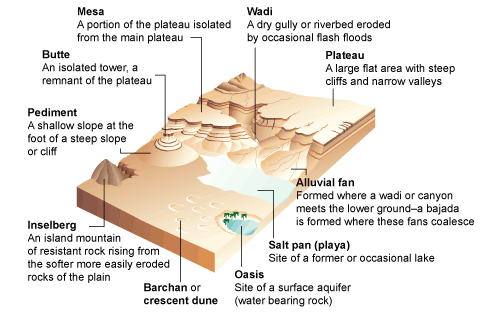
- Bajada & Pediment: The floor of the desert depression is made up of two features viz. Bajada & Pediment.
- Bajada
- Depositional feature made up of alluvial material lay down by intermittent streams.
- Bajada is formed by the coalescence of alluvial fans
- These fan-shaped deposits form from the deposition of sediment by a stream from upland region onto flat land at the base of a mountain
- Bajadas are common in arid areas where a large quantity of sediment is deposited by flash floods
- Bajadas frequently contain playa lakes
- Pediment
- An erosional plain formed at the base of the surrounding mountain scarps -steep slope.
- They are gently inclined rocky floors close to the mountains at their foot with or without a thin cover of debris.
- They form through the erosion of mountain front through a combination of lateral erosion by streams and sheet flooding.
- Through parallel retreat of slopes, the pediments extend backwards at the expense of mountain front
- Gradually, the mountain gets reduced leaving an inselberg which is a remnant of the mountain.
- That’s how the high relief in desert areas is reduced to low featureless plains called pediplains.
- Bajada
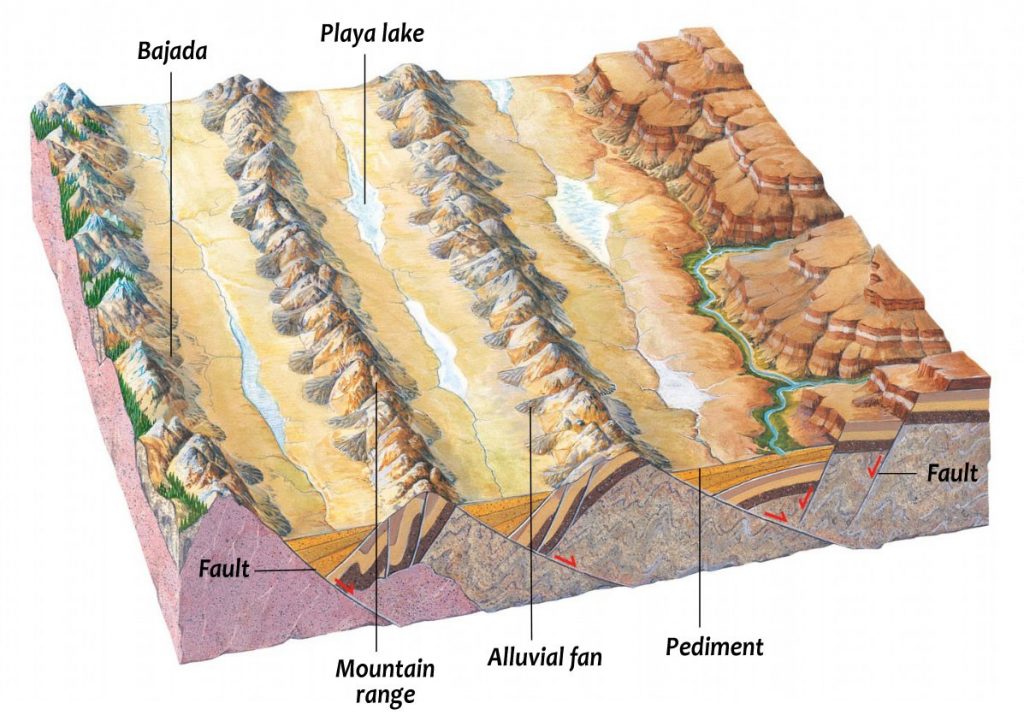
- Alluvium fans
- Alluvium fans are cone shaped heaps of sand that are deposited on the exit of a wadi or valley.
- A wadi is a narrow dry valley with ephemeral water flow (water that flows during heavy rains only). The valley is dry and baked most of the time, but during heavy downpours they can fill up with water and transport all the alluvium from the upslope as sheet wash.
- This alluvium is deposited as the wadi terminates into an open space. Energy is dissipated in the open space and material spreads apart into a fan shape.
- Canyons/Gorges
- Gorges (canyons in America) are deep narrow valleys that are excavated and eroded vertically by rivers that flow along deserts.
- The Grand Canyon in Arizona USA was formed by vertical erosion of sedimentary strata by the Colorado River for millions of years.
